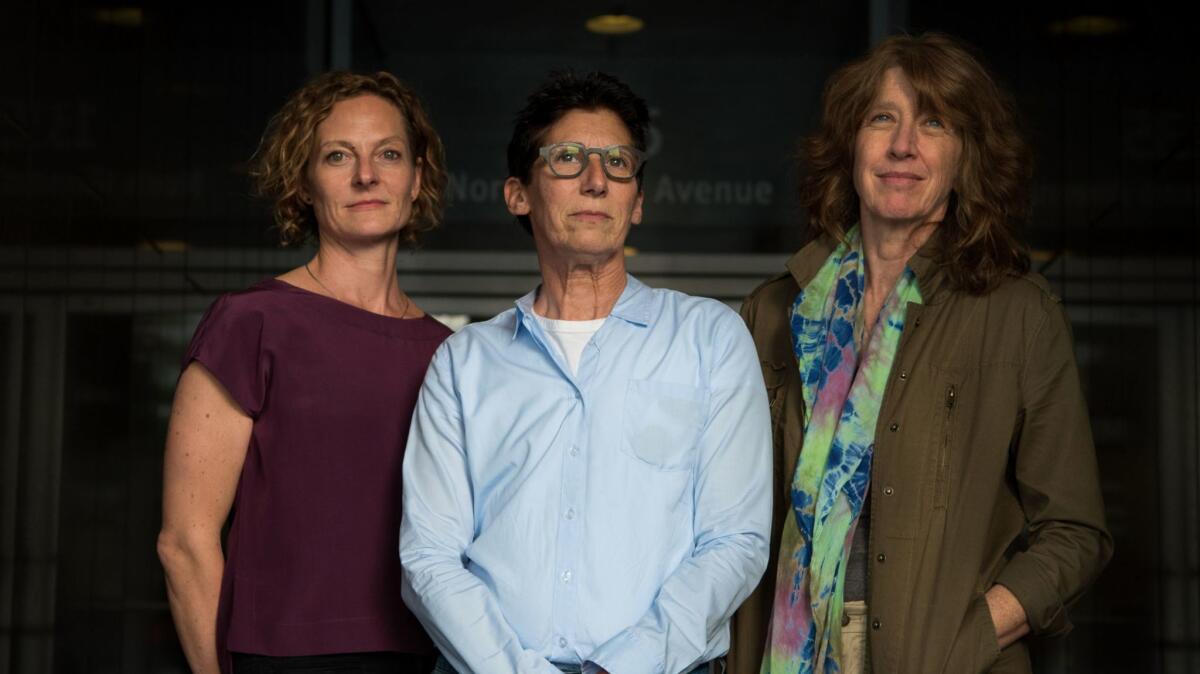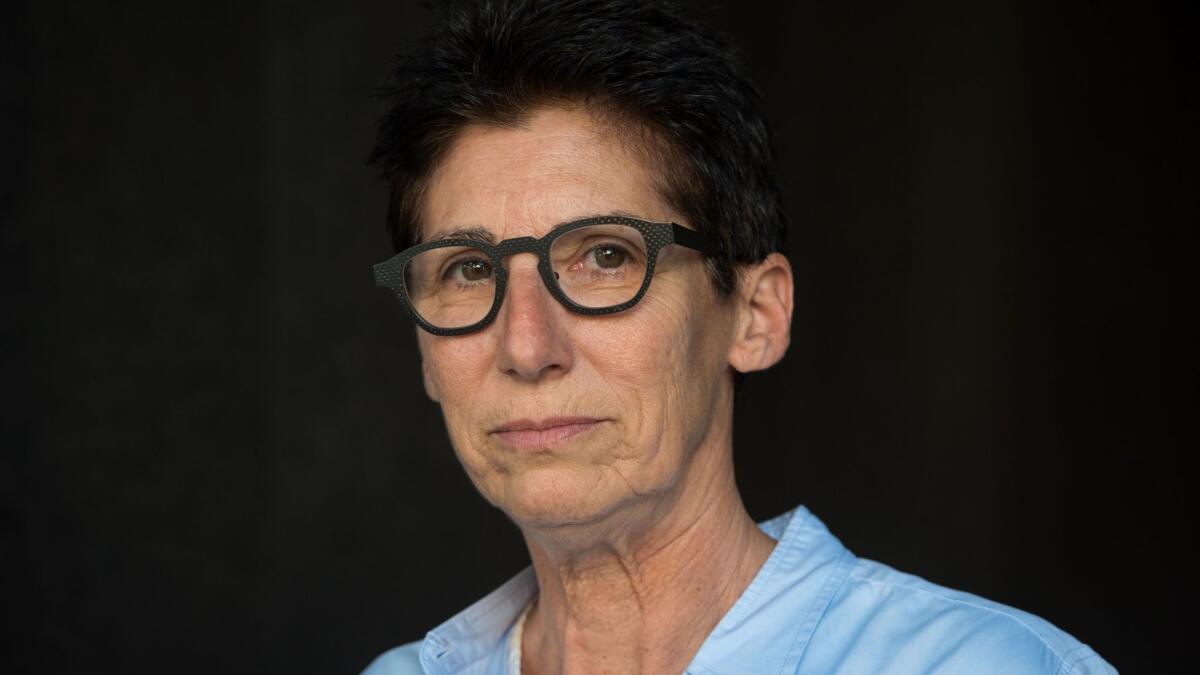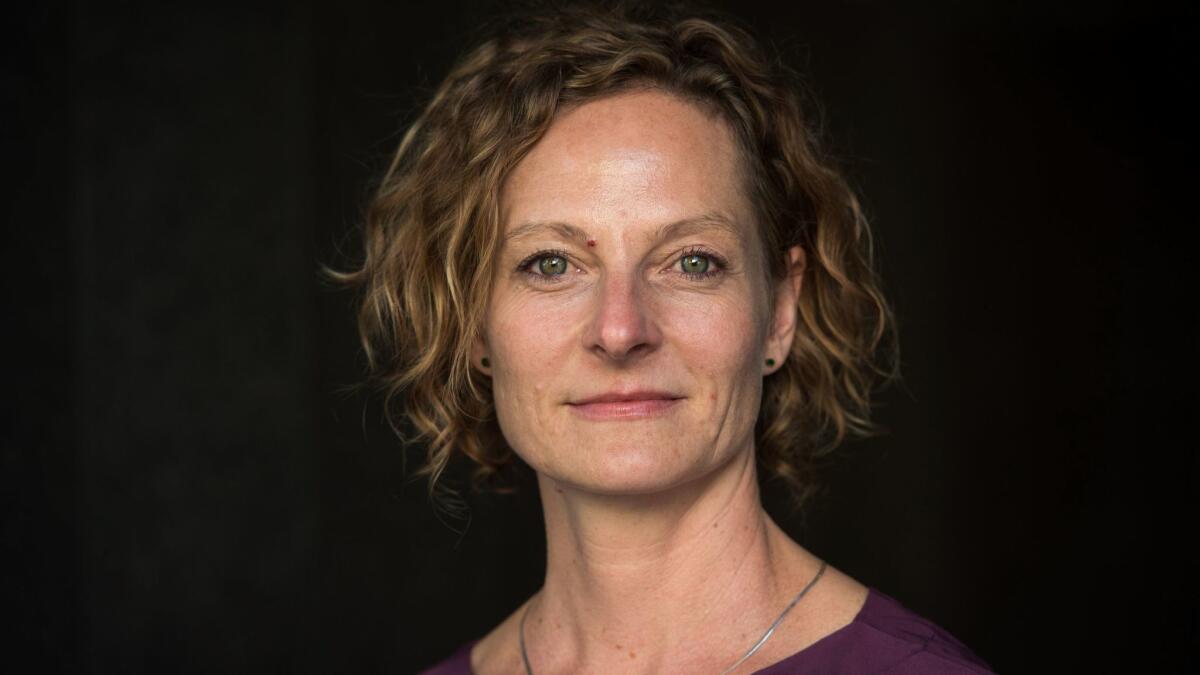Olivier Messiaen wrote music in a Nazi prison camp. Artist Susan Silton has asked women to perform it

- Share via
On a bitterly cold night in January 1941, French composer Olivier Messiaen debuted a new work.
It was an unusual premiere. Messiaen’s audience was an assembly of war prisoners and their guards. The concert hall was an unheated barrack in a Nazi prison camp near the Polish-German border where Messiaen, who had served in the French Army, was being held as a prisoner himself.
The composition, “Quartet for the End of Time,” was a piece of chamber music in eight movements inspired by themes of the apocalypse as described in the Revelation of St. John in the Christian Bible. The musicians played an unusual combination of instruments: piano, cello, violin and clarinet. These were the only ones available to the composer during his roughly two years in detention. At that first recital, Messiaen played the piano. Fellow POWs rounded out the rest of the ensemble.
Los Angeles artist Susan Silton can’t quite remember when she first stumbled onto Messiaen’s legendary work, which New Yorker music critic Alex Ross describes as the “most ethereally beautiful music of the 20th century.”
Perhaps it was on the radio, perhaps a music streaming service. What she knows is that it was in the wake of last fall’s U.S. presidential election — and her reaction to the work’s dissonant piano chords and siren clarinet notes was immediate.
“It created this visceral response,” she says. “I put on this piece and it made me weep … I didn’t know its history when I cried. Then I researched it and I find out its incredible history.”
She was so moved, that she is now staging “Quartet for the End of Time” for an experimental production on Friday and Saturday in downtown Los Angeles.
His interest was in collapsing time into the infinite. That’s what he meant by the ‘end of time.’
— Susan Silton, artist

As a prologue, actor Cristina Frias will read a text inspired by the writings of Hannah Arendt. A dance component has been developed by independent choreographer Flora Wiegmann, known for her spare approach to movement. All of this will unfold on two stages separated by a scrim through which musicians and dancers will travel back and forth in space and time.
“The miracle of the quartet,” wrote Times critic Mark Swed in 2008, “in which bird song is used to represent freedom and gloriously colored harmonies the glory of infinity, is its transcendence of time and space.”
Messiaen, who died in 1992, regularly toyed with ideas about time, doing away with traditional meters and the development of themes.
“His interest was in collapsing time into the infinite,” Silton says. “That’s what he meant by the ‘end of time.’”
“Some of the movements are so slow that time really seems to stop — it’s kind of suspended,” says Silton’s collaborator Vicki Ray, a Grammy-nominated pianist and a founding member of Piano Spheres, a group that promotes the creation and performance of major new piano compositions. “He’s really trying to evoke this sense of time completely stopping.”
It has some of the most rapturously beautiful music ever written in the cello solos and the violin solos.
— Vicki Ray, pianist

The presentation will take place not at a concert hall, but in a bare industrial warehouse in the Arts District — one whose functional brick-and-concrete architecture better evokes the chilliness of Stalag VIIIA, where Messiaen was held.
It’s a space, says Silton, “that has this sense of oppressiveness inside.”
Perhaps most interestingly: The production will consist entirely of women.
“I wanted it to be in stark contrast to what the original context was,” says Silton. “Between how it was first presented according to Messiaen, with male POWs and played by men … and how I felt I wanted the work to be.”
Part of her desire to produce the piece with women was prompted by the election. “I always want to insist on our presence,” she says, “but in the shadow of this president, I believe it’s even more critical that we insist, and persist.”
The performance is part of a series of new site-specific pieces for downtown Los Angeles organized by the arts nonprofit Los Angeles Nomadic Division. In addition to Silton’s performance, the series, titled “Exchange Value,” also includes upcoming works by Los Angeles artist Olga Koumoundouros, artist and filmmaker Alison O’Daniel and the duo of Iván Navarro and Courtney Smith.
Shamim Momin, the director of LAND, as the organization is known, says she was immediately drawn to Silton’s project.
“It was this idea of coerced beauty, how we can be forced into this creative process,” she says, “this opportunity to explore problematic themes and things that can give you insight.”
Silton is an artist whose work incorporates many forms, including photography and printmaking. In the latter case, she produces optical art-inspired works that toy with human perception.
She also regularly stages performances. In 2013, she gathered a circle of volunteers at USC’s Fisher Museum for a collective re-typing of John Steinbeck’s “The Grapes of Wrath.” Last year, she created a public opera, “A Sublime Madness in the Soul,” that could be viewed from the now-demolished 6th Street Bridge in downtown Los Angeles.
For Messiaen’s “Quartet for the End of Time,” she was intrigued by what the work represented and found herself wanting to work with it — even though she is not a musician herself.
“The perseverance of the spirit, of the artistic spirit,” she says. “I was struck by the range of emotion from one movement to the next. Some movements are extremely angst-ridden and angry — and not so much assaultive, but reflective of passion and oppression. Others are extremely quiet and poignant and accepting.”
Its message, and the story of the conditions under which it was made, felt especially poignant to her in this fractured political time. “I felt so vividly that the piece reaches all of those emotions that I’m feeling in this present moment.”
So she reached out to Ray, whom she had once seen perform a work by Morton Feldman at LAXART. To her surprise, the pianist — who has played “Quartet for the End of Time” on more than half a dozen occasions over her career — immediately signed on, compelled by the music, which she describes as “landmark.”
“It has some of the most rapturously beautiful music ever written in the cello solos and the violin solos,” Ray says. “When you get done playing the quartet, you feel like you’ve been through some kind of alchemical process. You come out inspired, elevated, exhausted and rewarded; it’s cathartic every time you play it.”
“Also, her concept of using all women is interesting,” she adds. “I think as a person who is very involved in the women’s movement, I feel like it will be interesting to see what kind of singular power an all-woman group brings to it. The players I’ve picked are ferocious and they can be ferocious — but also incredibly tender.”
Messiaen was asking them to do things that pushed them to the limits of their own instruments and their ability to play.
— Flora Wiegmann, choreographer

Wiegmann, likewise, was equally intrigued — by the incredible story behind Messiaen’s composition, but also by the challenge it presented on the level of choreography.
“It is such a dynamically diverse piece,” she says. “It shifts so many times. It’s truly incredible and unpredictable. After listening to it over and over, I said, ‘Yes, I would love to be involved!’”
Her goal, she says, is to help reveal the boundary-breaking nature of the composition without overshadowing it.
“It’s about highlighting,” she says. “It’s about giving an added dimension to experiencing the sound.”
She says she continuously thinks of the bleak conditions under which the original musicians performed: Messiaen, along with cellist Étienne Pasquier, violinist Jean Le Boulaire and clarinetist Henri Akoka (an Algerian Jew who somewhat miraculously survived the war).
“Thinking about how the musicians have described learning their part for this — it was probably frustrating and thrilling,” she says. “Messiaen was asking them to do things that pushed them to the limits of their own instruments and their ability to play. For me, it’s trying to physicalize that and understand it.”
In the end Silton is hopeful that, above all, she can stage not just a meaningful concert, but create a space for sound and thought, a moment for viewers to consider history and the lessons it might offer us at this moment in time.
“Messiaen wanted to banish time, I want to emphasize time,” she says. “Responding to time and to history — it’s the only hope.”
“Quartet for the End of Time”
Where: 1399 Factory Place, Los Angeles
When: 8:30 p.m. Friday and Saturday
Admission: Free, but space is limited; RSVP required
Info: nomadicdivision.org
Sign up for our weekly Essential Arts & Culture newsletter »
ALSO
Saying goodbye to the 6th Street Bridge with artist Susan Silton’s ‘Sublime Madness’ opera
Vijay Iyer jazzes up the Ojai Music Festival
‘The Other Mozart’? Her name was Maria Anna, and she dazzlingly comes to life onstage
More to Read
The biggest entertainment stories
Get our big stories about Hollywood, film, television, music, arts, culture and more right in your inbox as soon as they publish.
You may occasionally receive promotional content from the Los Angeles Times.











